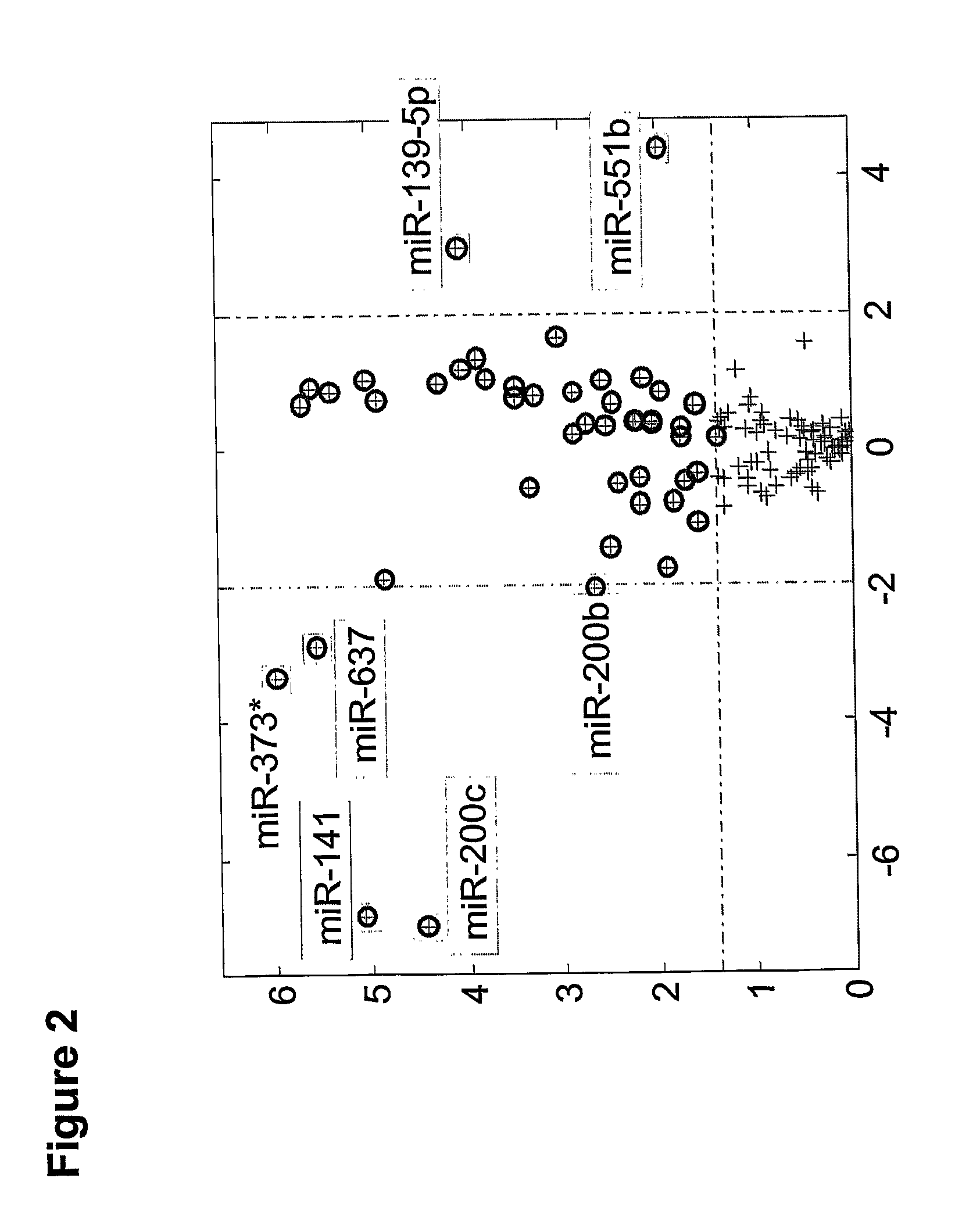Gene expression signature for classification of kidney tumors
a gene expression and tumor technology, applied in the field of microorganisms, can solve the problems of generating a more difficult diagnostic challenge, limiting the accuracy of histological classification, and underlying biological mechanisms playing important roles in these tumors are yet to be elucidated
- Summary
- Abstract
- Description
- Claims
- Application Information
AI Technical Summary
Benefits of technology
Problems solved by technology
Method used
Image
Examples
example 1
Specific microRNAs are Differentially Expressed Between Different Histological Subtypes of Kidney Tumors
[0238]127 formalin-fixed, paraffin-embedded (FFPE) samples of renal tumors were collected, including 40 oncocytoma samples, 27 chromophobe samples, 34 conventional (clear) cell samples, and 26 papillary tumor samples. The initial sample set used for biomarker identification and for training a classifier included 71 samples. Total RNA was extracted from these samples, and microRNA expression was profiled using microarrays.
[0239]We first looked for microRNAs that are differentially expressed between different histological subtypes of kidney tumors. We compared the expression of microRNAs between oncocytoma samples (n=21), chromophobe tumors (n=13), conventional cell tumors (n=17), and papillary tumors (n=20). More than 900 microRNAs were compared using statistical tests. MicroRNAs were considered differentially expressed between any two histological types if their t-test significanc...
example 2
Specific MicroRNAs are Able to Distinguish Between Oncocytoma Renal Tumor Samples and Chromophobe RCC Samples
[0246]The analysis of the microarray results of oncocytoma renal tumor samples versus chromophobe RCC samples are presented in Table 4. The results exhibited a significant difference in the expression pattern of several mills. The normalized expression levels of hsa-miR-141 (SEQ ID NO: 32) and hsa-miR-200c (SEQ ID NO: 34) were found to be higher in chromophobe RCC samples in comparison to oncocytoma renal tumor samples. The normalized expression levels of hsa-miR-140-5p (SEQ ID NO: 28), hsa-miR-139-5p (SEQ ID NO: 14) and hsa-miR-551b (SEQ ID NO: 30) were found to be higher in oncocytoma renal tumor samples in comparison to chromophobe RCC samples.
TABLE 4miRHairpinmiRSEQ IDSEQ IDfold-median valuesnameNoNO.p-valuechangegroup 1group 2Up regulated in chromophobe RCC:hsa-miR-14132336.60E−05152.267.60E+035.00E+01hsa-miR-200c34352.10E−0499.528.00E+038.00E+01Down regulated in chromop...
example 3
Specific MicroRNAs are Able to Distinguish Between Oncocytoma Renal Tumor Samples and Clear Cell RCC Samples
[0247]The analysis of the microarray results of oncocytoma renal tumor samples versus clear cell RCC samples are presented in Table 5. The results exhibited a significant difference in the expression pattern of several miRs. The normalized expression levels of hsa-miR-551b (SEQ ID NO: 30), hsa-miR-182 (SEQ ID NO: 36), hsa-miR-221 (SEQ ID NO: 25), hsa-miR-222 (SEQ ID NO: 26), hsa-miR-10a (SEQ ID NO: 48) and MID-00536 (SEQ ID NO: 38) were found to be higher in oncocytoma renal tumor samples in comparison to clear cell RCC samples. The normalized expression levels of hsa-miR-21 (SEQ ID NO: 47), hsa-miR-210 (SEQ ID NO: 20), hsa-miR-192 (SEQ ID NO: 6), hsa-miR-194 (SEQ ID NO: 1), hsa-miR-146b-5p (SEQ ID NO: 16), hsa-miR-155 (SEQ ID NO: 22) and hsa-miR-455-3p (SEQ ID NO: 24) were found to be higher in clear cell RCC samples in comparison to oncocytoma renal tumor samples.
TABLE 5miRH...
PUM
| Property | Measurement | Unit |
|---|---|---|
| Tm | aaaaa | aaaaa |
| temperature | aaaaa | aaaaa |
| temperature | aaaaa | aaaaa |
Abstract
Description
Claims
Application Information
 Login to View More
Login to View More - R&D
- Intellectual Property
- Life Sciences
- Materials
- Tech Scout
- Unparalleled Data Quality
- Higher Quality Content
- 60% Fewer Hallucinations
Browse by: Latest US Patents, China's latest patents, Technical Efficacy Thesaurus, Application Domain, Technology Topic, Popular Technical Reports.
© 2025 PatSnap. All rights reserved.Legal|Privacy policy|Modern Slavery Act Transparency Statement|Sitemap|About US| Contact US: help@patsnap.com



